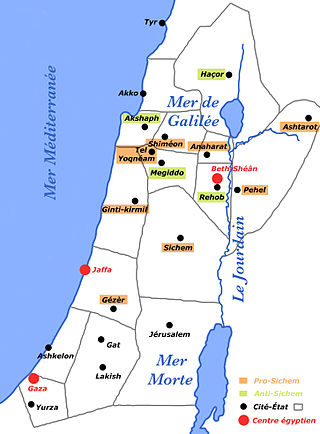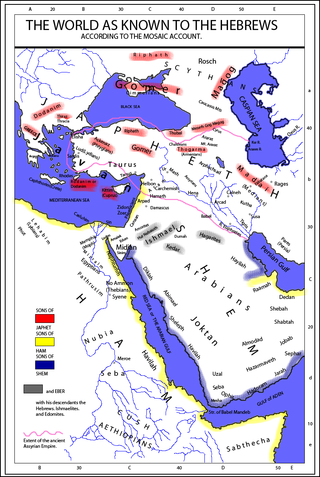The Levant is the area in Southwest Asia, south of the Taurus Mountains, bounded by the Mediterranean Sea in the west, the Arabian Desert in the south, and Mesopotamia in the east. It stretches 400 mi (640 km) north to south from the Taurus Mountains to the Sinai desert, and 70–100 mi (110–160 km) east to west between the sea and the Arabian desert. The term is also sometimes used to refer to modern events or states in the region immediately bordering the eastern Mediterranean Sea: the Hatay Province of Turkey, Cyprus, Syria, Lebanon, Israel, and Jordan.

The history of ancient Israel and Judah begins in the Southern Levant region of Western Asia during the Late Bronze Age and Early Iron Age. "Israel" as a people or tribal confederation appears for the first time in the Merneptah Stele, an inscription from ancient Egypt that dates to about 1208 BCE, with the people group possibly being older. According to modern archaeology, ancient Israelite culture developed as an outgrowth from the Semitic Canaanites. Two related Israelite polities known as the Kingdom of Israel (Samaria) and the Kingdom of Judah had emerged in the region by Iron Age II.

The Philistines were an ancient people who lived on the south coast of Canaan during the Iron Age.

Canaan was a Semitic-speaking civilization and region of the Southern Levant in the Ancient Near East during the late 2nd millennium BC. Canaan had significant geopolitical importance in the Late Bronze Age Amarna Period as the area where the spheres of interest of the Egyptian, Hittite, Mitanni and Assyrian Empires converged or overlapped. Much of present-day knowledge about Canaan stems from archaeological excavation in this area at sites such as Tel Hazor, Tel Megiddo, En Esur, and Gezer.

Ugarit was an ancient port city in northern Syria, in the outskirts of modern Latakia, discovered by accident in 1928 with the Ugaritic texts. Its ruins are often called Ras Shamra after the headland where they lie.
Ugaritic is an extinct Northwest Semitic language, classified by some as a dialect of the Amorite language. It is known through the Ugaritic texts discovered by French archaeologists in 1929 at Ugarit, including several major literary texts, notably the Baal cycle. It has been used by scholars of the Hebrew Bible to clarify Biblical Hebrew texts and has revealed ways in which the cultures of ancient Israel and Judah found parallels in the neighboring cultures.

Asherah in ancient Semitic religion, is a fertility goddess who appears in a number of ancient sources. She also appears in Hittite writings as Ašerdu(s) or Ašertu(s). Her name is sometimes rendered Athirat in the context of her cult at Ugarit.

The Jebusites were, according to the books of Joshua and Samuel from the Tanakh, a Canaanite tribe that inhabited Jerusalem, then called Jebus prior to the conquest initiated by Joshua and completed by King David, although a majority of scholars agree that the Book of Joshua holds little historical value for early Israel and most likely reflects a much later period. The Books of Kings as well as 1 Chronicles state that Jerusalem was known as Jebus prior to this event. The identification of Jebus with Jerusalem is sometimes disputed by scholars. According to some biblical chronologies, the city was conquered by King David in 1003 BCE.

Caphtor is a locality mentioned in the Bible, in which its people are called Caphtorites or Caphtorim and are named as a division of the ancient Egyptians. Caphtor is also mentioned in ancient inscriptions from Egypt, Mari, and Ugarit. Jewish sources placed Caphtor in the region of Pelusium, though modern sources tend to associate it with localities such as Cilicia, Cyprus, or Crete.
The Canaanite languages, or Canaanite dialects, are one of three subgroups of the Northwest Semitic languages, the others being Aramaic and Amorite, all originating in the Levant and Mesopotamia. They are attested in Canaanite inscriptions throughout the Levant, Mesopotamia, Anatolia and the East Mediterranean, and after the founding of Carthage by Phoenician colonists, in coastal regions of North Africa and Iberian Peninsula also. Dialects have been labelled primarily with reference to Biblical geography: Hebrew, Phoenician/Punic, Amorite, Ammonite, Moabite, Sutean and Edomite; the dialects were all mutually intelligible, being no more differentiated than geographical varieties of Modern English. This family of languages has the distinction of being the first historically attested group of languages to use an alphabet, derived from the Proto-Canaanite alphabet, to record their writings, as opposed to the far earlier Cuneiform logographic/syllabic writing of the region, which originated in Mesopotamia.
Ancient Semitic religion encompasses the polytheistic religions of the Semitic peoples from the ancient Near East and Northeast Africa. Since the term Semitic itself represents a rough category when referring to cultures, as opposed to languages, the definitive bounds of the term "ancient Semitic religion" are only approximate.
The religions of the ancient Near East were mostly polytheistic, with some examples of monolatry. Some scholars believe that the similarities between these religions indicate that the religions are related, a belief known as patternism.

The Canaanite religion was the group of ancient Semitic religions practiced by the Canaanites living in the ancient Levant from at least the early Bronze Age through the first centuries AD. Canaanite religion was polytheistic and, in some cases, monolatristic. Some gods and goddesses were absorbed into the Yahwist religion of the ancient Israelites, notably El, Baal and Asherah, until the Babylonian captivity where they worshipped Yahweh alone.
Cyrus Herzl Gordon was an American scholar of Near Eastern cultures and ancient languages.

Gath or Gat, often referred to as Gath of the Philistines, was a major Philistine city and one of the five Philistine city-states during the Iron Age. It was located in northeastern Philistia, close to the border with Judah. Gath is often mentioned in the Hebrew Bible and its existence is confirmed by Egyptian inscriptions. Already of significance during the Bronze Age, the city is believed to be mentioned in the El-Amarna letters as Gimti/Gintu, ruled by the two Shuwardata and 'Abdi-Ashtarti. Another Gath, known as Ginti-kirmil also appears in the Amarna letters.

The Philistine language is the extinct language of the Philistines. Very little is known about the language, of which a handful of words survived as cultural loanwords in Biblical Hebrew, describing specifically Philistine institutions, like the seranim, the "lords" of the Philistine five cities, or the ’argáz receptacle, which occurs in 1 Samuel 6 and nowhere else, or the title padî.

Many place names in Palestine were Arabized forms of ancient Hebrew and Canaanite place-names used in biblical times or later Aramaic formations. Most of these names have been handed down for thousands of years though their meaning was understood by only a few. The cultural interchange fostered by the various successive empires to have ruled the region is apparent in its place names. Any particular place can be known by the different names used in the past, with each of these corresponding to a historical period. For example, the city of Beit Shean, today in Israel, was known during the Israelite period as Beth-shean, under Hellenistic rule and Roman rule as Scythopolis, and under Arab and Islamic rule as Beisan.

The Amorites were an ancient Northwest Semitic-speaking people from the Levant who also occupied large parts of southern Mesopotamia from the 21st century BC to the late 17th century BC. There, they established several prominent city-states in existing locations, such as Isin, Larsa and later notably Babylon and created the Old Babylonian Empire. The term Amurru in Akkadian and Sumerian texts refers to the Amorites, their principal deity and an Amorite kingdom. The term Amorite was never used in contemporary sources before the 1st millennium BC. The Amorites are mentioned in the Bible as inhabitants of Canaan both before and after the conquest of the land under Joshua.
Daniel Edward Fleming is an American biblical scholar and Assyriologist whose work centers on Hebrew Bible interpretation and cultural history, ancient Syria, Emar, ancient religion, and the interplay of ancient Near Eastern societies. Since 1990, he has served as a professor of Hebrew Bible and Ancient Near Eastern Studies in the Skirball Department of Hebrew and Judaic Studies at New York University, where he has spent his whole career.

The Ugaritic texts are a corpus of ancient cuneiform texts discovered since 1928 in Ugarit and Ras Ibn Hani in Syria, and written in Ugaritic, an otherwise unknown Northwest Semitic language. Approximately 1,500 texts and fragments have been found to date. The texts were written in the 13th and 12th centuries BCE.